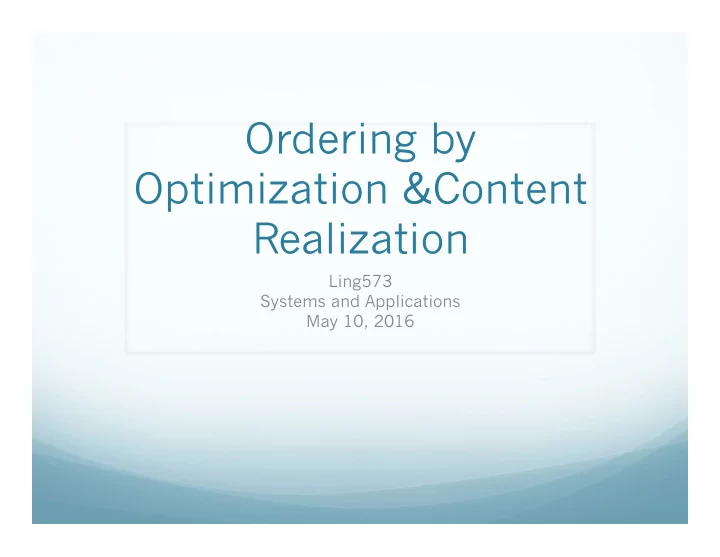

Ordering by Optimization &Content Realization Ling573 Systems and Applications May 10, 2016
Roadmap Ordering by Optimization Content realization Goals Broad approaches Implementation exemplars
Ordering as Optimization Given a set of sentences to order Define a local pairwise coherence score b/t sentences Compute a total order optimizing local distances Can we do this efficiently? Optimal ordering of this type is equivalent to TSP Traveling Salesperson Problem: Given a list of cities and distances between cities, find the shortest route that visits each city exactly once and returns to the origin city. TSP is NP-complete (NP-hard)
Ordering as TSP Can we do this practically? Summaries are 100 words, so 6-10 sentences 10 sentences have how many possible orders? O(n!) Not impossible Alternatively, Use an approximation methods Take the best of a sample
CLASSY 2006 Formulates ordering as TSP Requires pairwise sentence distance measure Term-based similarity: # of overlapping terms Document similarity: Multiply by a weight if in the same document (there, 1.6) Normalize to between 0 and 1 (sqrt of product of selfsim) Make distance: subtract from 1
Practicalities of Ordering Brute force: O(n!) “there are only 3,628,800 ways to order 10 sentences plus a lead sentence, so exhaustive search is feasible.“ ( Conroy) Still,.. Used sample set to pick best Candidates: Random Single-swap changes from good candidates 50K enough to consistently generate minimum cost order
Conclusions Many cues to ordering: Temporal, coherence, cohesion Chronology, topic structure, entity transitions, similarity Strategies: Heuristic, machine learned; supervised, unsupervised Incremental build-up versus generate & rank Issues: Domain independence, semantic similarity, reference
Content Realization
Goals of Content Realization Abstractive summaries: Content selection works over concepts Need to produce important concepts in fluent NL Extractive summaries: Already working with NL sentences Extreme compression: e.g 60 byte summaries: headlines Increase information: Remove verbose, unnecessary content More space left for new information Increase readability, fluency Present content from multiple docs, non-adjacent sents Improve content scoring Remove distractors, boost scores: i.e. % signature terms in doc
Broad Approaches Abstractive summaries: Complex Q-A: template-based methods More generally: full NLG: concept-to-text Extractive summaries: Sentence compression: Remove “unnecessary” phrases: Information? Readability? Sentence reformulation: Reference handling Information? Readability? Sentence fusion: Merge content from multiple sents
Sentence Compression Main strategies: Heuristic approaches Deep vs Shallow processing Information- vs readability- oriented Machine-learning approaches Sequence models HMM, CRF Deep vs Shallow information Integration with selection Pre/post-processing; Candidate selection: heuristic/learned
Form CLASSY ISCI UMd SumBasic+ Cornell Initial Adverbials Y M Y Y Y Initial Conj Y Y Y Gerund Phr. Y M M Y M Rel clause appos Y M Y Y Other adv Y Numeric: ages, Y Junk (byline, edit) Y Y Attributives Y Y Y Y Manner modifiers M Y M Y Temporal modifiers M Y Y Y POS: det, that, MD Y XP over XP Y PPs (w/, w/o constraint) Y Preposed Adjuncts Y SBARs Y M Conjuncts Y Content in parentheses Y Y
Shallow, Heuristic CLASSY 2006 Pre-processing! Improved ROUGE Previously used automatic POS tag patterns: error-prone Lexical & punctuation surface-form patterns “function” word lists: Prep, conj, det; adv, gerund; punct Removes: Junk: bylines, editorial Sentence-initial adv, conj phrase (up to comma) Sentence medial adv (“also”), ages Gerund (-ing) phrases Rel. clause attributives, attributions w/o quotes Conservative: < 3% error (vs 25% w/POS)
Deep, Minimal, Heuristic ICSI/UTD: Use an Integer Linear Programming approach to solve Trimming: Goal: Readability (not info squeezing) Removes temporal expressions, manner modifiers, “said” Why?: “next Thursday” Methodology: Automatic SRL labeling over dependencies SRL not perfect: How can we handle? Restrict to high-confidence labels Improved ROUGE on (some) training data Also improved linguistic quality scores
Example A ban against bistros A ban against bistros providing plastic bags providing plastic bags free of charge will be free of charge will be lifted at the beginning lifted. of March.
Deep, Extensive, Heuristic Both UMD & SumBasic+ Based on output of phrase structure parse UMD: Originally designed for headline generation Goal: Information squeezing, compress to add content Approach: (UMd) Ordered cascade of increasingly aggressive rules Subsumes many earlier compressions Adds headline oriented rules (e.g. removing MD, DT) Adds rules to drop large portions of structure E.g. halves of AND/OR, wholescale SBAR/PP deletion
Integrating Compression & Selection Simplest strategy: (Classy, SumBasic+) Deterministic, compressed sentence replaces original Multi-candidate approaches: (most others) Generate sentences at multiple levels of compression Possibly constrained by: compression ratio, minimum len E.g. exclude: < 50% original, < 5 words (ICSI) Add to original candidate sentences list Select based on overall content selection procedure Possibly include source sentence information E.g. only include single candidate per original sentence
Multi-Candidate Selection (UMd, Zajic et al. 2007, etc) Sentences selected by tuned weighted sum of feats Static: Position of sentence in document Relevance of sentence/document to query Centrality of sentence/document to topic cluster Computed as: IDF overlap or (average) Lucene similarity # of compression rules applied Dynamic: Redundancy: S= Π wi in S λ P(w|D) + (1- λ )P(w|C) # of sentences already taken from same document Significantly better on ROUGE-1 than uncompressed Grammaticality lousy (tuned on headlinese)
Recommend
More recommend